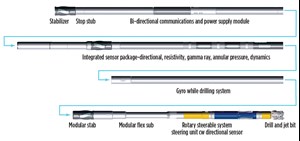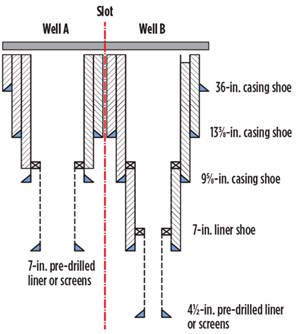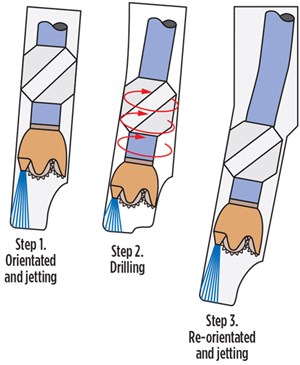Hybrid drilling technique improves offshore dual-conductor operations

Rotary steerable systems (RSS) are popular for drilling deviated wells, because of improved operational efficiency, reduced risk and the ability to drill more demanding well profiles to cost-effectively access additional reserves. Today, the continuously rotating drilling system is the standard technique in many applications, because of its ability to reduce torque and drag by drilling smoother trajectories, without high local doglegs. It also reduces operational risk from improved hole quality and cuttings removal in the high-inclination sections, which are common to extended-reach well profiles.
Oriented jetting was developed in the 1950s to control the trajectory of wells. Using this technique with the latest RSS technology and gyro measurement-while-drilling (MWD) tools can overcome the directional drilling challenges encountered in very weak surface sediments in offshore wells. Wells, that were previously very difficult to drill, are now drilled more quickly, and safely, using the hybrid RSS-jetting technique.
The hybrid technique has proven to be both reliable and cost-effective, allowing top-hole sections to be drilled to total depth (TD) at high inclinations, in a single bottomhole assembly (BHA) run, in very weak formations. The technique also provides additional benefits, such as:
- Enabling shallower kickoff points
- Reducing the risk and consequences of an inadvertent wellbore collision in very-close-proximity drilling
- Improving rates of penetration (ROP) and reducing openhole time in weak, unstable formations
- Improving hole quality for lower-risk casing runs.
Mature fields off the west coast of Africa present excellent examples. The geology of these reservoirs is complex, requiring several horizontal drainage points. Surface sediments are typically very weak. The issues associated with drilling directionally through these weak surface sediments, coupled with extremely close-proximity well drilling, present a challenge that has resulted in the development of the hybrid drilling technique, which has improved safety and operational efficiency—and with it, field economics and more productive well designs—for several mature fields in this area.
CLOSE-PROXIMITY DRILLING
In some mature offshore fields, extremely close-proximity drilling is a direct consequence of not only the maturity of the asset and high well count, but also the use of dual conductors. Dual, or shared, conductors allow two independent wells to be drilled from a common conductor. This technique enables cost-effective use of existing surface facilities to drill additional wells to new reservoir target locations, thus reducing overall field development costs.
Dual conductors are being employed increasingly in mature fields. Two independent wells are drilled from a single conductor. Each well uses standard hole sizes, with a smaller hole contingency. With more fields reaching maturity in various basins globally, it is anticipated that the need for dual-conductor techniques will grow.
When offshore platforms use dual conductors, the second well drilled from each conductor is, initially, in very close proximity to the first well for some distance beyond the conductor shoe. Well collision risk is normally managed by maintaining adequate physical separation from offset wells, and is based on the surveyed positions and the associated position uncertainty. Minimum allowable separation distances (MASDs) are specified, and are usually dependent on the risk status of the offset well. Most companies make a clear distinction between wells that represent a health, safety and environmental (HSE) risk versus only a financial risk, with HSE-risk offset wells assigned larger MASDs.
If the first well does not represent an HSE risk, the operator may make a financial risk assessment using the probability of penetration of, or damage to, the adjacent well. This assessment may take into account the use of mitigating drilling practices such as jetting, which is used to avoid collisions during the initial well trajectory kick-off. If, however, the adjacent well is on production at a pressure that represents an HSE risk, the HSE-risk MASD applies and is not negotiable. This principle is particularly important when drilling at a very shallow depth, before the BOPs are in place.
DIRECTIONAL DRILLING IN WEAK FORMATIONS
Performing directional drilling operations in top-hole sections through very weak shallow sediments is challenging. The unconsolidated formation rock with low confining stress tends to wash out, erode or collapse when drilled, changing the hole-gauge geometry and reducing steering control. The lack of reliable steering results in well kickoff points that must be planned deeper than what is optimal, especially for extended-reach wells or wells under multi-well platforms, where early well separation is advantageous for avoiding collisions. External factors also can play a more dominant role in influencing the steering performance of a given BHA design in weak rock, as opposed to more consolidated, homogeneous formations.
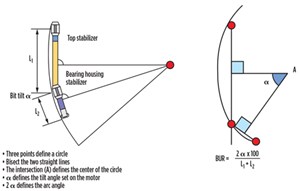
When designing wells where weak rock is expected, unconfined compressive strength (UCS) estimates, often available from log analyses, are useful as reference points. However, UCS, alone, is insufficient to reliably predict steering performance. Other factors, such as earth stresses—particularly in tectonic settings, borehole pressure and pore pressure—all play a significant role in how the rock behaves when drilled, and its resistance to mechanically and/or chemically induced overgauge hole. Careful selection of drilling technology is required, because some systems are better suited to operating in weak rock environments than others.
Steerable motor assemblies are used frequently for the initial kick-off and directional drilling work, because of their strong performance record in these applications. It is common practice to set the bend on a motor, such that the overall required curvature in the well can be achieved with approximately 50% slide drilling and 50% rotation, Fig. 1.
Higher proportions of sliding may be necessary in weak rock because of the unpredictable steering response; therefore, as a design basis, setting the system up for a 50:50 slide/rotate ratio provides some leeway in response. However, setting the bend in the motor too high a tilt angle risks introducing high, local dogleg severity, which potentially can increase drilling torque, increase casing or drillstring wear, and cause problems running certain completion equipment, such as ESPs later in the construction of the well.
Additionally, a higher bend on the motor can cause the inclination to drop when rotating ahead as the hole is undercut. This can result in the need for additional slide drilling, which negates the benefit of the high tilt angle. Because of these challenges, directional work is often planned to begin at as deep a point as is possible, while still meeting well deviation and target objectives. This may not be optimal for the well design.
In close-proximity drilling operations, an additional challenge of drilling with a steerable motor is that the drill bit is rotating continuously, with the potential to deliver very high power from the drilling motor at all times when circulating. Less predictable steering response in weak rock, combined with the fact that the directional sensors (normally in an MWD system), are located several meters from the drill bit, increases the risk of drilling off plan and colliding with an offset well. If a collision takes place, the continuous rotation of the drill bit on the steerable motor has the potential to impart damage to the outer structure of the offset well. The damage has the potential to be significant, but difficult to quantify.
The ability of different RSS’s to steer in weak rock varies widely, depending on their operating principles and details in design. Those with a track record of reliable operations apply a steady force against the borehole wall from externally expanding pads, with large contact areas mounted on a slow or non-rotating sleeve. These systems deflect the BHA in the hole, providing steady bit offset and tilt angle.
Factors that aid reliable steering in weak rock include the following.
- The rock behind the steady-state pads is strengthened, limiting penetration of the pad into the borehole wall.
- The inherent active stabilization provided by the expandable pads, maintaining constant pressure against the wellbore, delivers a laterally stable environment for the drill bit to cut an in-gauge hole.
- The compact three points of geometry mean that there is less openhole time for the wellbore to deteriorate or wash out before the third point of contact is passed.
- Hole cleaning, enhanced by continuous drillstring rotation, enables lower flowrates to be employed and reduces hole erosion.
An improved system for drilling in very weak surface sediments, where offset wells necessitate critical steering at shallow depth to avoid collision risk, would be a low-energy drilling system, with reliable steering. This conclusion led to the development of a new, hybrid system that combines rotary steerable technology, with directional jetting.
HYBRID RSS/DIRECTIONAL JETTING
Specially designed “jet-bits” and associated directional drilling techniques were developed in the Louisiana Gulf Coast area, and introduced to the industry in the early 1950s as a method of deflecting wellbores. The wellbore was deviated by the jetting action of the drilling fluid exiting a bit nozzle, oriented in the desired direction and eroding the wellbore wall in that direction. Jet-bit deflection is still used in extreme circumstances, when even steerable motors are unable to perform a kick-off in very soft, sandy formations.
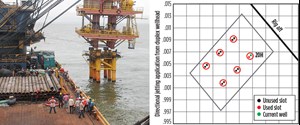
The system typically includes a Tricone drill-bit dressed with a directional nozzle setup of one large and two rear nozzles, with the center nozzle blanked; a near-bit stabilizer; MWD system; non-magnetic drill collar; stabilizer, drill collar and stabilizer, Fig. 2. In 2008, Baker Hughes tested a prototype that combined directional jetting with RSS technology. Initial attempts were unsuccessful, but lessons learned from those runs have been applied successfully, more recently.
Following a blowout incident offshore Nigeria in 2010, several West African offshore operators reviewed their top-hole drilling practices. Some operators replaced all mud motor assemblies with directional jetting BHAs, to ensure safe drilling with separation factors below 1.0. This change required two BHA runs to reach section TD. The second run, with a steerable mud motor, was defined by the jetting refusal point of the first jetting BHA. In at least one case, an additional 12 hrs of rig time were required to replace the jetting BHA and increase the openhole time until the casing was run—an operation that is critical in soft formation top holes, because the hole deteriorates with time and can collapse. The requirement for two BHA runs was the catalyst to trial the directional jetting-with-RSS technique.
During several trial runs, the system was fine-tuned and optimum drilling parameters were obtained for both the jetting and rotary steering operational modes. Four successful runs of the system to TD took place in 2013, and the new system became the standard top-hole drilling system for an operator in Nigeria. As of October 2014, 21 wells had been drilled with the system, Figs. 3, 4.
HYBRID DRILLING TECHNIQUE
Prior to running in hole, the large nozzle in the drill bit is aligned with the gyro MWD toolface, equivalent to the orientation of the highside toolface of a steerable motor. At the conductor shoe, the large nozzle of the drill bit is oriented to the desired azimuth, and jetting begins by increasing flowrate to 900 gpm with zero string rotation. At this stage in the well, this technique has been shown to reliably deliver 3°/100-ft dogleg severity, with higher dogleg severities achieved frequently. String rotation must be kept at zero at all times, while the anti-collision separation factor from the adjacent well is below 1.0, to avoid damage to the neighboring casing in the event of contact, Fig. 5.
At approximately 1,100 ft, MD, the formation becomes more firm, and jetting ROP reduces, ultimately to a point of refusal, where no further progress is possible while jetting without rotation. By this point, the well is safely clear of offset wells, and drill-string rotation can commence with the RSS steering in its normal rotary steering operating mode. Since the formation at this point in the well is still quite weak, it is necessary to use minimum flow rate and very slow string rotation to achieve the required steering response—typically 3°/100 ft—to stay on the planned trajectory. As the formation continues to become more firm with increasing depth, flowrate and rotary speed can be increased incrementally, governed by steering response, as indicated by the near-bit directional sensor in the RSS and also through monitoring rotation of the system’s slow-rotating sleeve. This continuous rotation benefits hole-cleaning efficiency, as these hole sections typically reach TD at high inclination. As each stand of drill pipe is drilled down, and prior to making a connection, care must be taken not to back-ream the hole excessively, or inclination may be lost through undercutting the drilled hole.
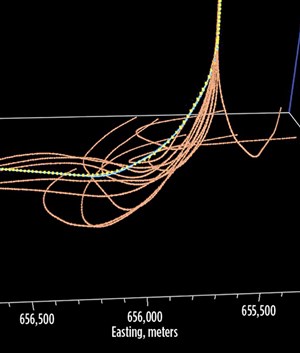
The benefits of the RSS/jetting technique include:
- Reliably kicking off the well immediately below the conductor shoe, even when the first casing has been installed;
- Reliably building angle and gaining rapid separation distance from the well shared in the conductor and any other close-proximity wells;
- Early confirmation of steering performance provided by directional sensor positioned 1 m above drill bit;
- Reducing risk of severe damage to a close-proximity offset well, in the event of an unintended collision through zero bit rotation while jetting;
- Early kick-off in extended reach wells, which reduces sail-angle inclination and optimizes well design for both drilling and future intervention operations; and
- Drilling the section to TD in one run, with no requirement to pull out of the hole with a steerable motor or traditional directional jetting BHA, to replace it with an RSS BHA.
FUTURE APPLICATIONS
The experience of directionally jetting with RSS shows that achievable build-up rates are approximately twice that of steerable motor assemblies, Fig. 6. The trajectories, which are now possible, will change the way that future extended-reach wells are designed, further reducing torque and drag, optimizing trajectories and increasing achievable step-out. With more offshore fields reaching maturity in various basins globally, it is anticipated that the need for dual-conductor techniques in very weak, shallow-sediment directional drilling will grow, and with it, the benefits of advanced methods, such as RSS with directional jetting. ![]()
ACKNOWLEDGMENT
This article was adapted from SPE paper 173057, presented at the SPE/IADC Drilling Conference and Exhibition in London, March 17-19, 2015.
- Applying ultra-deep LWD resistivity technology successfully in a SAGD operation (May 2019)
- Adoption of wireless intelligent completions advances (May 2019)
- Majors double down as takeaway crunch eases (April 2019)
- What’s new in well logging and formation evaluation (April 2019)
- Qualification of a 20,000-psi subsea BOP: A collaborative approach (February 2019)
- ConocoPhillips’ Greg Leveille sees rapid trajectory of technical advancement continuing (February 2019)

